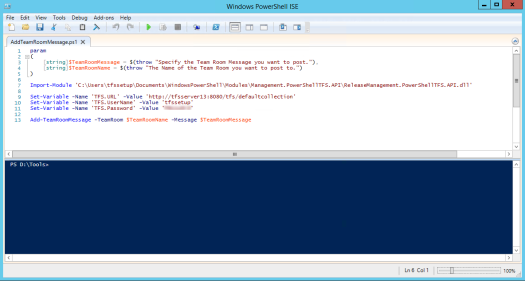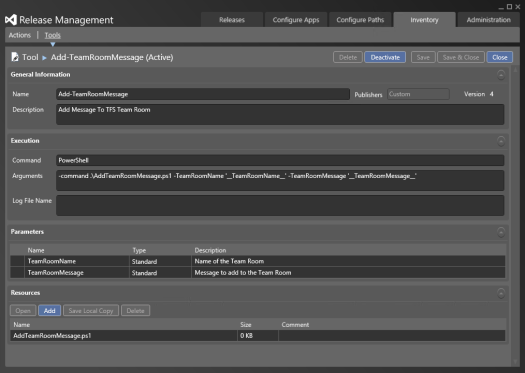This is Part 3 in the series on Release Management + PowerShell + TFS TeamRoom API. In this post I am going to utilize the PowerShell Enabled TFS Team Room API logic from a Release Template in Visual Studio Release Management.
I will not cover a ‘usual’ flow that will release an application based on a Team Foundation Server build, if you like more information on this please check out my post covering that here: Release Management with InRelease
Or you can check out my Curation on Release Management here: Getting Started with Release Mangement
In Part 2 of this series I figured out all the PowerShell commands needed to post a message to the Team Room. Now let’s advance.
Visual Studio Release Management allows for creating custom tools. To create a Tool a Custom PowerShell Script can be used, so let’s make a script that can post the message. You can use the PowerShell ISE Editor to create this script.
A little clarification on the script. It has two parameters, TeamRoomMessage and TeamRoomName. I choose not to pass all the TFS configuration to the script, but if you want you can 🙂
After declaring the parameters, the module (Wrapper to the Team Room API) is imported. Then variables are set and the call to the Team Room is made passing the received parameters.
Creating the tool in Visual Studio Release Management is fairly easy. Most important part is adding the PowerShell script as a resource. On the Execution section we specify that the tool is a PowerShell command.
Our script needs two parameters and those need to be passed as arguments to the script. Mind that the parameters are qouted otherwise spaces in the message might break the script.
Having created the tool we need to create an Action to be able to add this to the Release Template. The creation of the Action is quite similar to the creation of the tool.
Having the Tool and the Action ready we can continue to create a very simple Release Path to post a message. The Release Path is using an existing stage (Development) and an existing environment (Development Environment). Acceptance and validation are both set to be automatic. This way no manual actions are required.
Now that we have a Release Path available, we need to create a Release Template. On the Deployment Sequence we drag our target server. Next in to Toolbox we browse to the Custom Section. In the section we can find our Custom Action. Drag this action to the Server surface. It lists the two parameters that our action needs, which now can be provided.
After saving, on the top menu there is the possibility to create a “New Release”, provide it a unique name and our Release Template is pre-selected.
Let go and start the release! After starting the release you will see the Release Progress. As acceptance was set to be automatic, that step is automatically passed. Next the Deploy step is executed, status is Pending.
After a little waiting (posting the message doesn’t take that long) this will transfer to Done.
For the Deploy step there are details available. You can review these by clicking the ‘…’ button. The Deployment Log screen will be shown.
Through the View Log button we can see the log that is created during our ‘Add TeamRoomMessage’ action. The log message contains the output generated in our PowerShell Script. As we can see below it says our message is successfully posted!
The only place to find out if that’s true is to head over to our Team Room and see for our self! As expected the message is there!
As mentioned in the previous posts I promised to all the source code required for this complete series. You can download the source for this here: Release Management – Distribution.zip
Please note that this code was written for demo purposes only and is not intended to run on your production environment.
If you have any questions or remarks please feel free to leave a comment or contact me on twitter @jaspergilhuis











